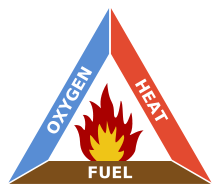Fire: Keeping safe
This task is about identifying fire hazards, and using what you know about fire to suggest ways to make a situation safer.
If we know what causes fires we are more likely to be able to manage the risk of a fire starting.
For a fire to start, three things have to be present:
- a source of heat
- fuel
- oxygen
This is often called the fire triangle.


